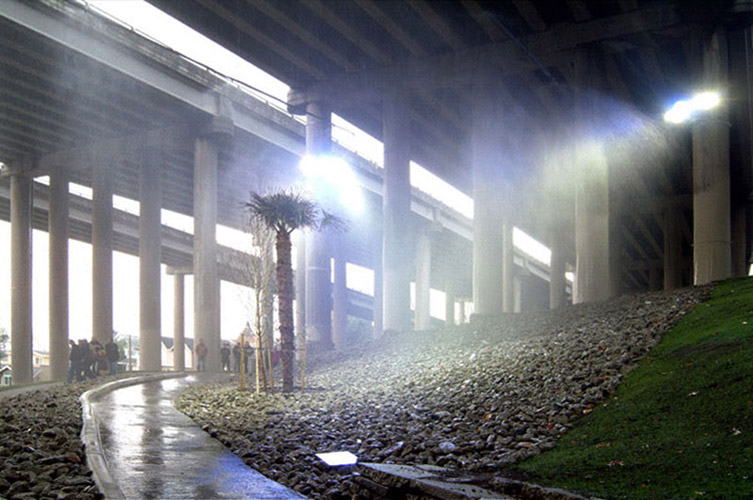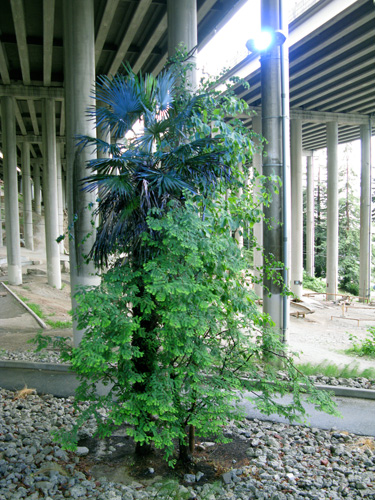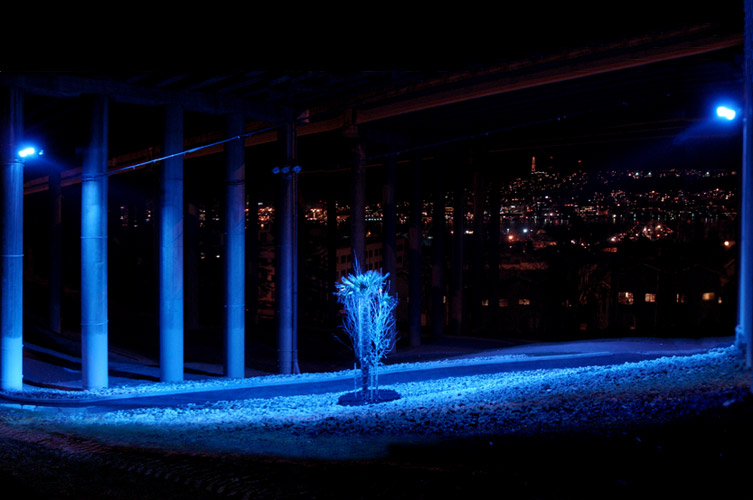Seventh
Climate (Paradise Reconsidered), 2006, emerges
from the interaction of six elements each representing a different
climate, memory and/or ecology: four species of trees, each from
a distinct biome/terrains planted to form one organism, a simulation
by lighting and artificial rain of the 1960 Seattle, pre-freeway
precipitation, sunlight and moonlight cycles, and the current
ambient weather of Seattle.
Sited under the I-5 freeway in Seattle, WA as part of the new
I-5 Colonnade Park, this project engages properties of this
unique site, a space with its own ecology, rain/light, shadow
and topographic
properties. The site is related to but separate from other
Seattle ecological systems, affording a special opportunity
to explore
the concept of ecology outside of typical definitions with
radical if not disparate/displaced combinations or conjunctions
of elements.
The installation of freeway in the early 1960’s necessitated
the removal and dislocation of a portion of the Eastlake neighborhood,
there are no recognizable remains of the streets, houses or biota
of that neighborhood except the several streets dead-ending into
the freeway’s under space.
Filling and framing the space underneath one main segment of
the central of three freeways that pass overhead, The Seventh
Climate (Paradise Reconsidered) creates a meta-system that
brings together the interaction of global representatives in
the form
of selected tree species and a symbolic dissolution of a section
of the I-5 freeway through a simulation/mimicry of the external
Seattle, pre-freeway climate of 1960, to create an alternative,
symbiotic, ecology, and environment. A complex electronic program
activates an elevated mist/rain emission system and solar and
moonlight simulation lighting. The ground plane within the
zone of altered climate is of recycled concrete, a reflection
of the
overhead freeway and missing neighborhood's construction/deconstruction.
Four trees, optimally with a ‘white/ghost’ element
(flower, trunk, or foliage) each representing a different climate,
biome/terrain, tightly planted in the center of the site forming
a single arboreal structure. The lighting system is aimed at
the top 1/2 of the tree group, the rain system is in two linear,
overhead elements on either side and above the tree group. |
A
cumulative effect of the year-long light and moisture simulation
of the 1960 external
Seattle environment in this zone is to “remove” or “make
transparent” the section of freeway and it metaphorical
darkness, directly overhead, as in 1960, a year before the
freeway was built. The sun, moon and rain that had nourished
the site
before the freeway was built is symbolically reconstructed.
Within the interactive context and conditions created by the
freeway
site, cycling light, intermittent rain and arboreal growth,
these elements are asked to reconcile, adapt and engage with
each other,
forming new relationships and questions across bio-geographic,
meta-ecological boundaries/languages, cultural, industrial
and natural interdependency, collaboration and production.
The possibility
of a local alternative to distant eco-tourist destinations/meditation,
accessible by bus instead of jet is also suggested.
Antecedents:
The earliest climate-referenced work, Prairie
Starfish/Glacial Epoch, Qu’Appelle
River Valley, Saskatchewan, Canada1980,
involves an image from an mythical interpretation of ice age life, the use
of a living botanical or arboreal element as a major conceptual and physical
aspect of an environmental project begins with Collision: Lava Ship/Trellis
Ship, San Rafael, CA, 1985, a struggle of two time frames and systems:
botanical and pseudo-volcanic. Arboreal elements as climate and terrain representatives
was
first explored
in Lahontan Group II: Talking Tree/Glacial
Epoch, University of Reno, Reno,
NV, 1987, where, as part of the multi-phased, Lahontan
Group I-III, white
alder trees were planted as representatives of the contemporary Nevada climate
that would grow into and physically engage a large “fossil” structure
of artificial-snow covered steel creating a "conversation" between
the Ice Ages and the contemporary climate of Northern Nevada. Metafossil
(Pinus: Ponderosa, Radiata, Balfouriana), 1992, expands this idea, examining
inter-relationships of species and paleo-climatic migrations/ecologies. The
arboreal/terrain/climate
conversation and compression of elements, was further elaborated as selected
dense plantings of disparate species, similar to that employed in Seventh Climate..,
in a series of drawings/studies: Planting
Studies: Species/Climate-Zone Compression, I-IV, 1998. Study: Reef/Field (Florida Platform/Project
for an Ice Age), 1998,
considers similar ideas by proposing time/climate-displaced plantings on the
western continental shelf of Florida. |


